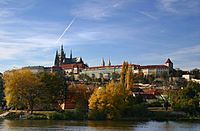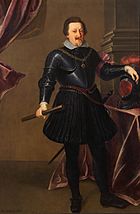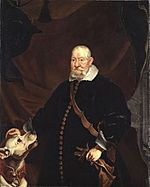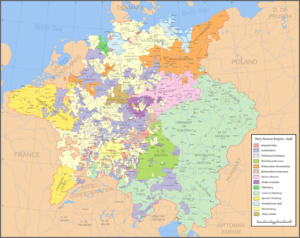Peace of Prague (1635) facts for kids

Prague Castle, where the treaty was discussed
|
|
| Signed | 30 May 1635 |
|---|---|
| Location | Prague Castle, Bohemia |
| Mediators | George II of Hesse-Darmstadt |
| Negotiators | |
| Original signatories |
|
| Signatories | Many others |
| Parties | |
| Languages | German |
The Peace of Prague (also called Pražský mír in Czech and Prager Frieden in German) was a very important agreement signed on May 30, 1635. It marked the end of Saxony's involvement in the Thirty Years War.
After this treaty, many other German rulers also joined in. Even though the Thirty Years' War continued, many historians agree that the Peace of Prague ended it as a religious war within the Holy Roman Empire. From then on, the conflict was mostly driven by powerful countries like Spain, Sweden, and France.
Some experts see this treaty as just one step towards the bigger Peace of Westphalia in 1648. But others believe it was a very important treaty on its own. It marked a clear change between two different periods in history.
Contents
Why the War Started

The Thirty Years' War began in 1618. It started when Frederick, a Protestant ruler, accepted the crown of Bohemia. Many Germans saw this as a family argument over who should rule.
With help from Bavaria, Emperor Ferdinand quickly stopped the rebellion in Bohemia. His troops invaded the Palatinate in 1622, forcing Frederick to leave. But taking away a prince's land changed the war. It made the conflict much bigger and more serious.
Religious Conflicts and New Laws
Christian IV of Denmark invaded northern Germany to support other Protestants. But he was defeated and had to leave in 1629. This success made Emperor Ferdinand pass a new law called the Edict of Restitution. This law said that any property taken since 1552 had to be given back to its original owner. Most of this property belonged to the Catholic Church.
This edict basically undid an older agreement from 1555, the Peace of Augsburg. It forced moderate Protestants, like John George of Saxony, to oppose the Emperor. Things got worse after 1627 when a large Imperial army was stationed on their lands. These soldiers were rarely paid, so they often just took what they wanted from the people.
Foreign Powers Join the Fight
Conflicts in Europe during the 1600s often involved foreign countries. This was because of the rivalry between the Bourbon kings of France and their Habsburg rivals. The Habsburgs ruled in Spain and the Holy Roman Empire.
Habsburg lands surrounded France, making France feel unsafe. Because of this, the Catholic French kings supported anyone who opposed the Habsburgs. This included the Ottomans, the Dutch, and the Danish-Norwegians, regardless of their religion.

In 1630, Gustavus Adolphus of Sweden invaded Germany. He had money from France and support from Saxony and Brandenburg-Prussia. After he died in 1632, Sweden formed the Heilbronn League. This group of smaller Protestant states was funded by France. They won many battles until they were defeated in 1634.
This defeat created a balance of power again. It also showed differences among the Heilbronn members. Sweden wanted to keep control of the valuable Baltic trade and the lands it had taken. France wanted to strengthen its borders. The German allies wanted to return to how things were in 1618, which meant undoing French and Swedish gains.
Steps Towards Peace
After 1632, Emperor Ferdinand realized he couldn't force everyone to be Catholic. He started talking about changing the Edict of Restitution in 1633. The death of Imperial Commander Albrecht von Wallenstein in 1634 also helped. He had become too powerful and independent.
With Lutheran states like Denmark-Norway and Hesse-Darmstadt helping as mediators, both sides agreed on a first draft in November 1634. This draft, called the Pirnaer Noteln, was the basis for the final agreement in 1635.
What the Treaty Said
The Peace of Prague was an agreement mainly between Emperor Ferdinand and John George of Saxony. Other states joined later. The discussions took eight days and happened at Prague Castle. This was the same place where the war had started in 1618.
Here are some of the main points of the treaty:
- The Edict of Restitution was mostly canceled. The date for returning properties was set as November 12, 1627. However, Protestant leaders of certain church lands were still not allowed to be part of the Imperial Diet (the empire's assembly).
- States within the Empire were not allowed to form alliances with each other or with foreign powers. This led to the end of groups like the Catholic League.
- In theory, all the armies of the different states were supposed to join together into one Army of the Holy Roman Empire. But this was very hard to make happen.
- A general pardon was given to most people who had fought against the Emperor. The only exception was the family of the "Winter King" Frederick V.
What Happened After the Treaty
States Joining the Treaty
Many other states and rulers later agreed to the Peace of Prague. These included:
- Principality of Calenberg and Duchy of Brunswick-Lüneburg
- Electorate of Brandenburg
- Electorate of Mainz
- Electorate of Cologne, Prince-Bishopric of Münster, and Prince-Bishopric of Paderborn
- Prince-Bishopric of Bamberg
- Landgraviate of Hesse-Darmstadt
- Saxe-Weimar and Saxe-Gotha
- Duchy of Mecklenburg-Schwerin
- The princes of Anhalt
- Countess Katharine of Lippe-Detmold
- Count of Zweibrücken-Hanau
- Hanseatic League cities like Hamburg and Bremen
- Several imperial cities such as Erfurt, Free City of Frankfurt, Memmingen, Nuremberg, and Ulm
- Electorate of Bavaria
There were a few exceptions:
- William V, Landgrave of Hesse-Kassel first joined the Peace of Prague. But in 1636, he made an alliance with France instead.
- The Imperial City of Strasbourg did not join the treaty.
- The Duchy of Württemberg was specifically left out of the treaty.
Changes in the Empire

Some states that joined the Peace of Prague received small benefits. For example, Brandenburg-Prussia was confirmed as the owner of Farther Pomerania.
In 1623, Saxony had taken control of parts of Bohemia. Under an agreement in 1636, Emperor Ferdinand gave these lands to Saxony forever. John George also received control of some church territories.
While Ferdinand continued to support the Catholic Church in his own lands, the Peace of Prague is generally seen as the end of the religious part of the war within the Empire. It brought back the idea that the ruler of a region could decide its religion. By giving up their right to form alliances and control their armies, the German states accepted the Emperor's power.
The War Continues
However, these rules were not always followed, and fighting continued. There was a bitter religious war between Hesse-Darmstadt and Hesse-Kassel. Foreign countries also kept getting involved.
On May 19, 1635, France declared war on Spain. While some German states joined the Peace, others continued fighting with France. In 1642, Sweden fought and won a big battle against Saxony. This made many German states decide to become neutral and make their own peace deals, separate from the Emperor. The different groups kept fighting, hoping to get a better deal. Peace was finally achieved with the Peace of Westphalia in 1648.
|
See also
 In Spanish: Paz de Praga para niños
In Spanish: Paz de Praga para niños

